Ever wonder how Japanese mornings feel so calm yet purposeful? Imagine steam rising from freshly cooked Japanese rice with natto, the savory warmth of miso soup, and a perfectly salted salmon glistening beside crisp pickles or maybe onsen tamago.
And it’s not just for mornings, you’ll crave this clean, savory harmony well past breakfast.

Japanese Breakfast Salmon
Recipe Snapshot
- What is it? Salted salmon with crisp skin and tender flesh.
- Flavor profile: Savory, Clean, Balanced
- Why you’ll love this recipe: It delivers the authentic Japanese breakfast you’ve been craving with only ingredients you can find anywhere.
- Must-haves: Fresh salmon fillet, Sea salt, Fish grill or oven broiler
- Skill Level: Easy
- Freezer Friendly? Yes!
- Suitable for Meal Prep? Yes!
Summarize & Save this content on:

What is Shiozake (Yakijake)?
Shiozake (塩鮭), or grilled salted salmon, is one of Japan’s most beloved home-style dishes. It’s made by sprinkling raw salmon with salt to draw out moisture and deepen its flavor before grilling until the skin crisps and the flesh flakes apart.
Originally a preservation technique, this simple process became a tradition that highlights the natural richness of the fish without fancy ingredients required. Today, Shiozake remains a staple of Japanese breakfasts and bento lunches.
Japanese Salted Salmon Ingredients

- Salmon (sake): You don’t need to hunt down a specific variety to make this work beautifully. At stores, you’ll most likely find Atlantic salmon (often Norwegian), which is great for this recipe. If you see sockeye or coho salmon, both still can deliver great flavor with slightly less richness. Fattier salmon tastes more mellow and luscious, leaner varieties let the salt shine through with a cleaner, more pronounced savory finish.
- Salt: It does all the heavy lifting here, drawing out moisture and concentrating flavor into something truly special. Fine-grain sea salt or kosher salt works perfectly for the initial salting stage. If you want that gorgeous looking crust, finish with a light sprinkle of coarse salt (like Maldon or flaky sea salt) right before grilling.
- Sake: A splash of sake gently perfumes the fish, softens “fishy” notes, and adds round umami. Think clean, warm rice aroma rising with the steam. This is totally optional.
Substitution Ideas
- Trout (Rainbow Trout, Steelhead): If salmon feels too pricey or you spot beautiful steelhead trout at the market, go for it. You’ll get a very similar experience with slightly milder, more delicate flavor. Jusr note that trout is naturally leaner than most salmon, so it won’t be quite as rich or forgiving if overcooked.
- If You Don’t Have Sake: No problem, dry sherry (look for “Fino” on the label) is your best stand-in. Dry white wine also works in a pinch, but honestly, this is a bonus ingredient, so feel free to skip it.
Have trouble finding Japanese ingredients? Check out my ultimate guide to Japanese ingredient substitutes!
How to Make My Japanese Breakfast Salmon
If you prefer to watch the process in action, check out my YouTube video of this shiozake recipe!
Before you start: Use skin-on fillets about 2.5-3 cm thick and remove any pin bones. Trim off visible bloodline or silvery membrane for a cleaner flavor, then rinse briefly and pat completely dry.
For a lean, delicate profile choose chum (that’s the domestic wild salmon in Japan), for richer, juicier results pick species with more fat like coho, sockeye, or farmed Atlantic. Really, any variety can works, so don’t worry too much about it. Skin-on helps protect the flesh.
i. Sprinkle a little sake over both sides, then season all surfaces with fine salt at roughly 1.5-2% of the fish’s weight (e.g., 3-4 g for a 200 g piece), sprinkling from ~30 cm up for even coverage.
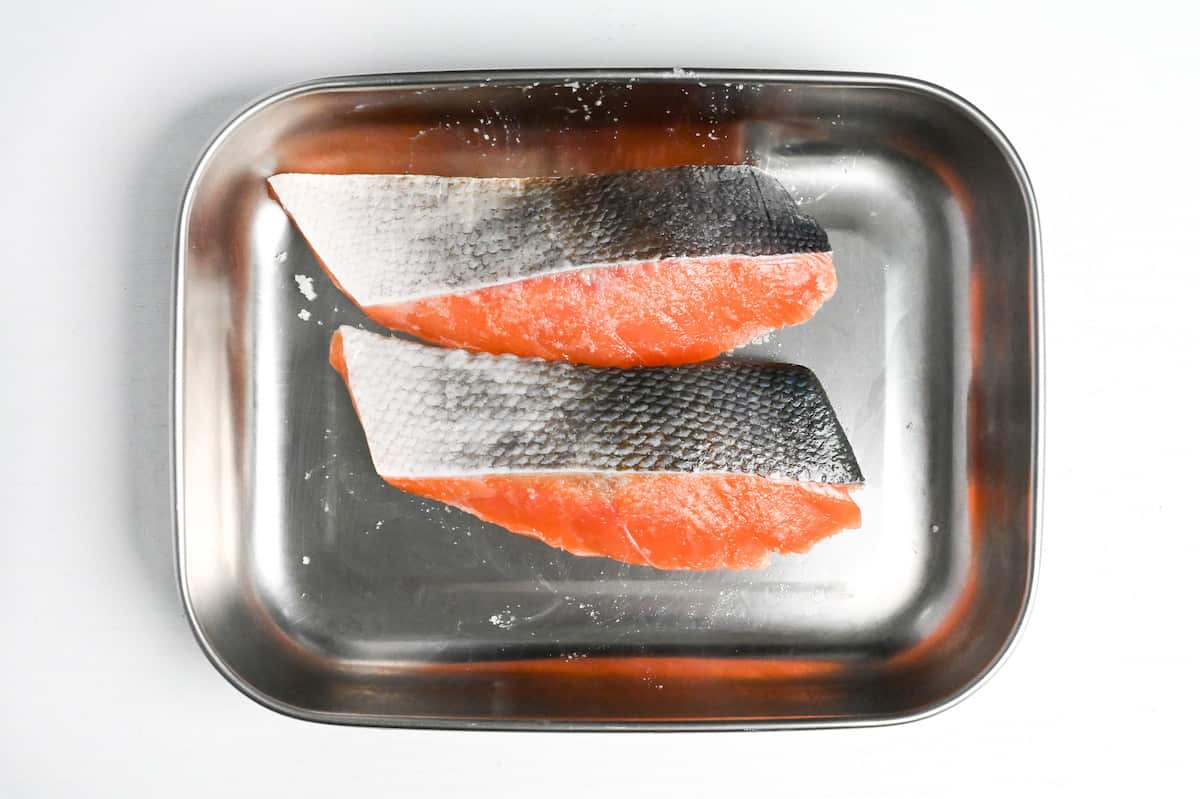
Sake helps tame fishy trimethylamine (TMA) and adds gentle aroma. Salt starts a light cure that firms the surface and seasons throughout. No sake? Dry sherry or a crisp white wine is a solid stand-in.
Traditional shiozake uses a slightly higher salt concentration, partly for preservation purposes. For more traditional flavor or shorter curing time, adjust the salt amount to around 2%. For a milder overnight cure, use about 1.5%, the longer curing time allows the salt to penetrate evenly at this lower concentration.
ii. Set the fillets on a rack over a tray and chill for at least 3 hours, ideally overnight. This concentrates flavor, firms the flesh, and dries the surface for better browning.
i. Preheat your oven’s broiler or stovetop fish grill over medium-high heat for about 5 minutes. A hot grill prevents sticking and jump-starts that prized crispy skin.
ii. While it heats, retrieve your salmon and blot the surface thoroughly with paper towels, erasing any remaining brine.

iii. For extra insurance against dryness, brush the skin side with a thin film of neutral oil (or skip it if your fish is naturally fatty). If you went extra amazing finish, pinch a small amount of coarse sea salt and sprinkle it over the flesh from high above.
i. Set the fish skin-side up directly under the broiler. Broil for about 5 minutes for a 2.5-3 cm fillet, with fat sizzling at the edges.
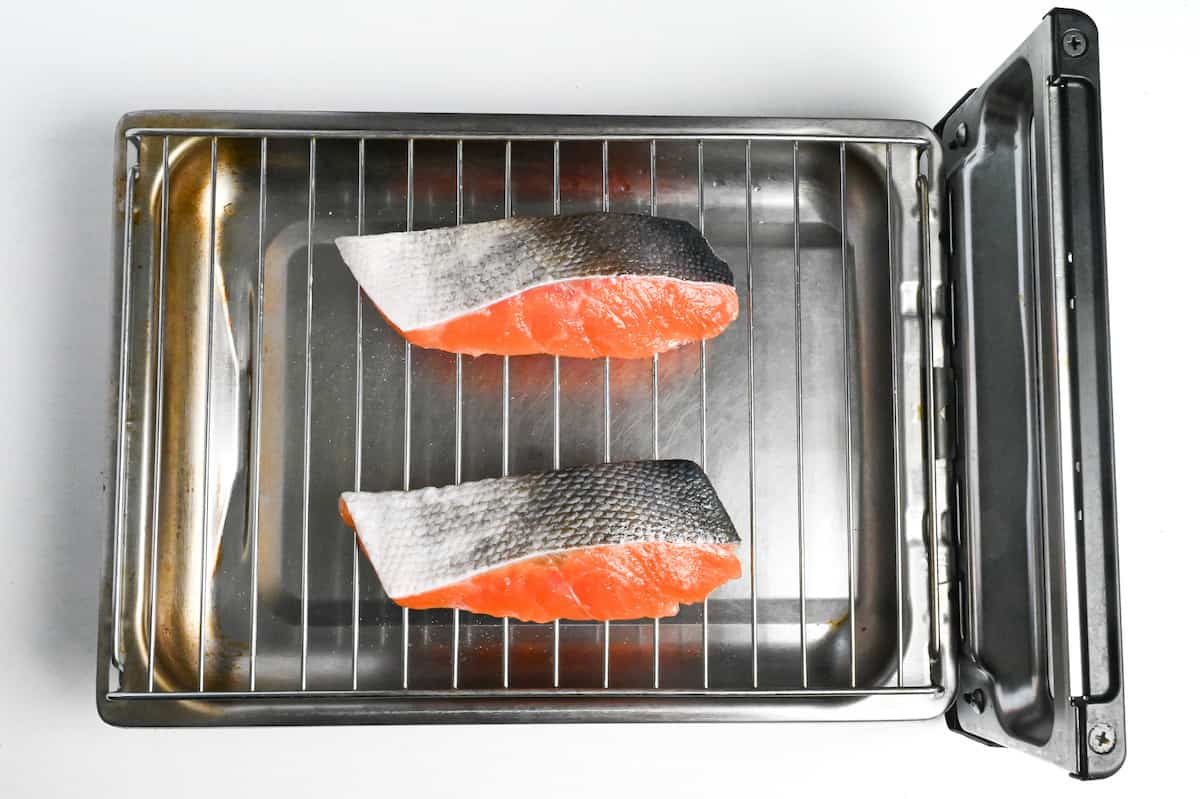
ii. For even cooking, turn the broiler off and let the fish rest in the hot oven for 2 minutes to finish gently with residual heat. If the underside still looks raw, flip once and give it a final 2 minutes on medium heat.
That white residue is albumin, a harmless, heat-coagulated protein that’s pushed to the surface as muscle fibers tighten. It’s more noticeable with hard, fast heat or overcooking. Prevent excess by not overcooking and by pre-salting. But even if it appears, there’s no problem.
iii. Slide a thermometer into the thickest part; 63℃ (145°F) is the conservative target. Without a thermometer, look for flakes to separate with gentle pressure and juices to run clear, not milky.
Cooking with different heat source:
| Method | Heat & Timing | Technique |
|---|---|---|
| Fish Grill / Oven Broiler (Base Recipe) | Preheat 5 min, Medium-high 5 min + 2 min residual | Skin-side up, no flip. Turn off heat after 5 min. |
| Stovetop Frying Pan | Medium-low 4-5 min covered + 30 sec uncovered | 1 tsp oil, skin-side down. Cover and steam, then flip to crisp skin. |
| Countertop Toaster Oven | 230°C (450°F), 10-15 min | Brush with oil, place on foil. No flipping needed. |
i. Slide your salmon onto a plate alongside steamed rice, a small bowl of miso soup, and a mound of grated daikon radish.
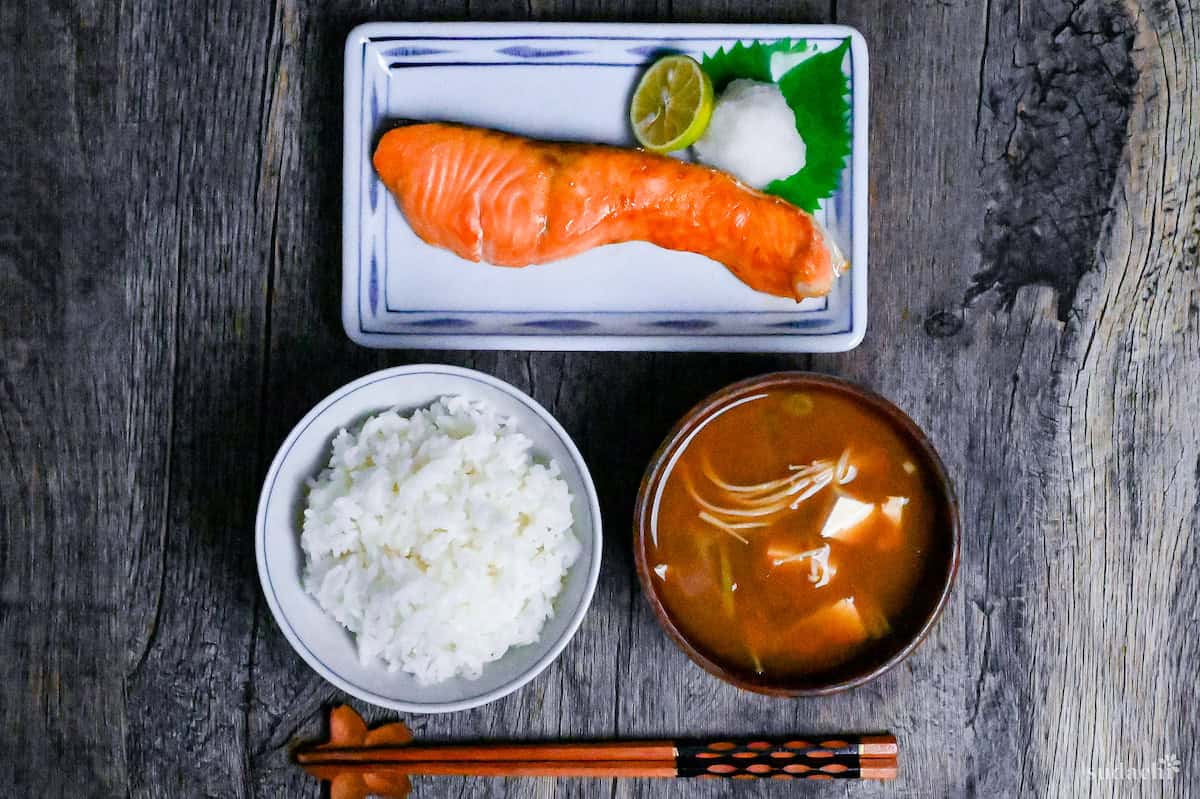
ii. Take your first bite plain and let that sweet-salty crust and tender interior speak for themselves. Halfway through, halve a citrus (or substitute a wedge of lemon or lime) and squeeze its tart juice over the fish.
Freshly grated daikon supplies amylase and protease (heat-sensitive) plus mustard-family pungency from isothiocyanates. So serve it raw and grate right before eating for the most effect.

Essential Tips & Tricks
- Let the fish rest at least 3 hours (or overnight) so flavor penetrates and moisture evens out.
- Always preheat your grill, pan, or broiler.
- Cook skin-side up under a grill or broiler, but skin-side down in a pan.
- Stop cooking when the center reaches 63 °C (145 °F) or flakes easily.
- Serve with fresh grated daikon to balance saltiness and refresh the palate.
With these simple tips in mind, you’re set for success every time you make shiozake.
Storage & Meal Prep
Fridge: Cooked salmon keeps 2-3 days in an airtight container. Homemade lightly salted (uncooked) salmon lasts up to 2-3 days refrigerated but should be cooked as soon as possible for freshness. You can always use the leftover for rice balls to make salmon onigiri.
Freezer: Both raw salted and cooked salmon can be frozen up to 1 month (best within 2 weeks).
Meal Prep: You can salt several fillets at once, rest them overnight, and store them raw (covered) for up to 3 days in the fridge or freeze them individually for easy future cooking.
Reheating: Reheat chilled salmon wrapped in foil in a toaster oven for about 5 minutes for moist results, or uncovered under a grill for 2-3 minutes if you want the skin crisp.
What to Serve With This Recipe
Shiozake Troubleshooting
Heat was too strong or the fillet too thick. Cook gently over medium-low heat and let carryover finish the center. Use even-thickness pieces or place thinner ends toward the cooler side of the grill or pan.
It was overcooked. Stop the heat a little early and let residual heat finish cooking. A moist finish should reach 63 °C (145 °F) at the center, not much higher.
The fish wasn’t salted long enough to firm the flesh, or the pan/grill wasn’t preheated. Salt at least 3 hours before cooking, preheat thoroughly, and oil the surface lightly to prevent sticking.
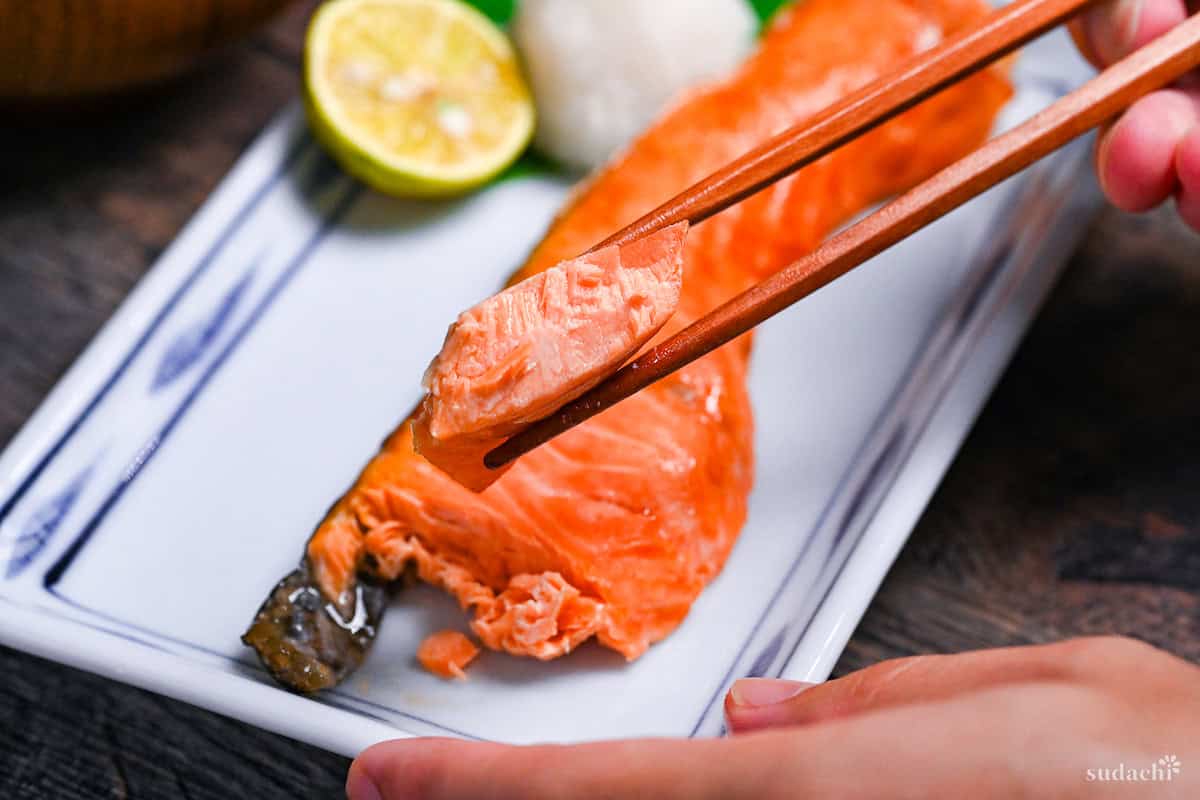
More Japanese Salmon Recipes
- Miso Glazed Salmon (pan-fried)
- Ponzu Salmon (Pan Fried)
- Pan Fried Japanese Teriyaki Salmon
- Salmon Flakes (Better Than Store-Bought!)
Craving more? Discover my collection of flavorful Japanese salmon dishes!
Did You Try This Recipe?
I would love to hear your thoughts!
💬 Leave a review and ⭐️ rating in the comments below. 📷 I also love to see your photos – submit them here!
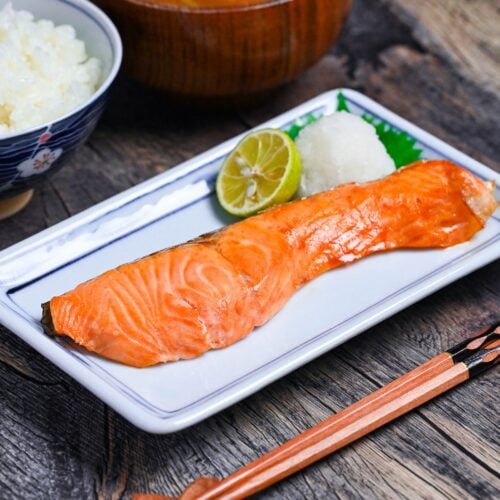
Japanese Salted Breakfast Salmon (Shiozake)
Ingredients
- 200 g salmon fillets skin-on, fresh, approx 2.5-3cm thick. Coho or Atlantic for richer flavor, chum for lighter taste
- 1 tsp sake optional, use dry sherry or white wine if unavailable
- 3-4 g salt fine sea salt preferred; use 1.5 % for overnight cure / 2.0 % for short 3 h cure
- 1 sudachi or lemon/lime wedge, optional for serving
- grated daikon radish (daikon oroshi)
My recommended brands of ingredients and seasonings can be found in my Japanese pantry guide.
Can’t find certain Japanese ingredients? See my substitution guide here.
Instructions
- Take 200 g salmon fillets and remove any pin bones. Trim off any visible bloodlines or silvery membranes, then rinse with cold water and pat dry. Rub both sides with 1 tsp sake (optional but improves flavor and texture).

- Sprinkle the salmon with 3-4 g salt. Sprinkle from a height for thinner and more even coverage, making sure to salt both sides. Set on a wire rack in an airtight container and refrigerate for at least 3 hours, preferably overnight.

- Preheat your grill or broiler on medium-high heat. While you wait, pat the salmon dry with kitchen paper. Once fully preheated, place the salmon with the skin side facing the heat source and grill/broil for 5 minutes, then turn off the heat and leave to cook in the residual heat for 2 minutes.

- If the underneath still looks raw, flip and grill the other side for 1-2 minutes to finish cooking it through.

- Plate up with 1 sudachi and a mound of grated daikon radish (daikon oroshi). Best served with rice and miso soup. Enjoy!

Video

Notes
- Grill/Broiler: Preheat 5 min, cook 5 min on medium-high, rest 2 min. Skin-side up, no flipping.
- Frying Pan: Medium-low 4-5 min covered + 30 sec uncovered, 1 tsp oil, skin-side down.
- Toaster Oven: 230 °C / 450 °F for 10-15 min, brushed with oil, no flipping.
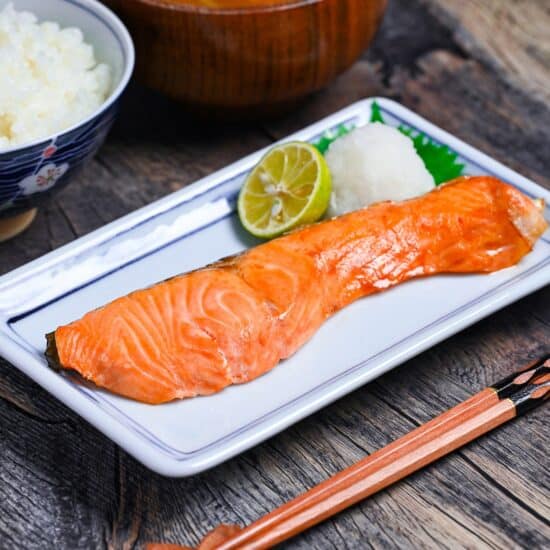



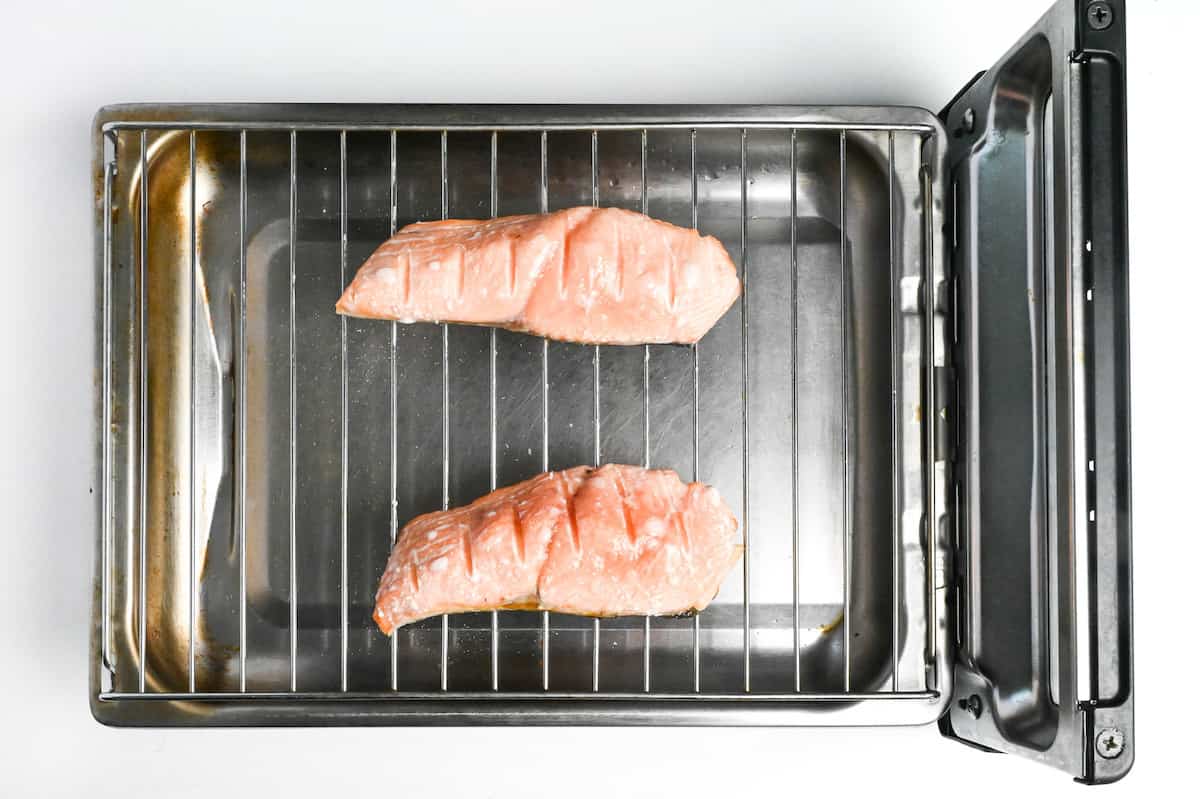
We felt it was a little simple and lacked some flavor. But it was a nice light way to have some protein!
Hi Grace,
Thank you for your comment and feedback!
Unfortunately, the dish is intended to be simple and only seasoned with salt for breakfast in Japan.
If you want more flavor while keeping the salmon light, you can try this Salmon Flake recipe (https://sudachirecipes.com/salmon-flakes/). It uses a bit of mirin, soy sauce, and butter!
Yuto
Funny!
You read my mind! I was just looking for a shiozake recipe.. will try to make it this week.. thanks
I’m glad that I posted at the right time! I hope you will enjoy! 🙂
Perfect!
Thank you, Jonas!